The 17 Best Trees to Plant in Illinois

Illinois is a great place to plant trees. There are many different types of trees that will do well in the state—each coming with its own attributes and benefits.
Here Are the Best Tree Types in Illinois:
Ash
Commonly found in Illinois’ yards and native to our forests, the white and green ash tree makes up as much as 20% of the trees used in local parkland. Ashes can easily be identified by their compound leaves made up of seven small, glossy, green leaflets. Additionally, while some varieties produce small paddle-shaped seeds, seedless specimens are both common and widespread.
Type of Tree: Most continental ash trees are deciduous—meaning that their leaves will go dormant and fall during the winter—but some subtropical varieties, such as the Shamel Ash, are classified as evergreens.
Varieties: There are 13 commonly found species of ash including black, green, white, and blue ash, California ash, Carolina ash, European ash, Gregg’s ash, manna ash, narrow leaf ash, pumpkin ash, velvet ash, and Manchurian ash. Of those, white and green are the most common in Illinois.
Height: 40-60 feet, with some white ashes reaching 80 feet when fully mature.
Spread: 40-50 feet.
Growth Rate: 1-2 feet per year. Depending on the variety, ash trees can take anywhere from 16-60 years to reach their full size.
Maximum Age: The average lifespan of the green ash is 120 years, with some specimens reaching more than 175 years old. The white ash will generally live to be about 260 years but can keep producing leaves in spring for more than 40 years after that.
Native to Illinois: Yes
Advantages:
- Grows well in most soil conditions.
- Tolerant of low moisture levels.
- Generally low maintenance.
Disadvantages:
- Vulnerable to the highly-destructive Emerald Ash Borer.
- Requires space and quality sunlight to reach maturity.
Birch
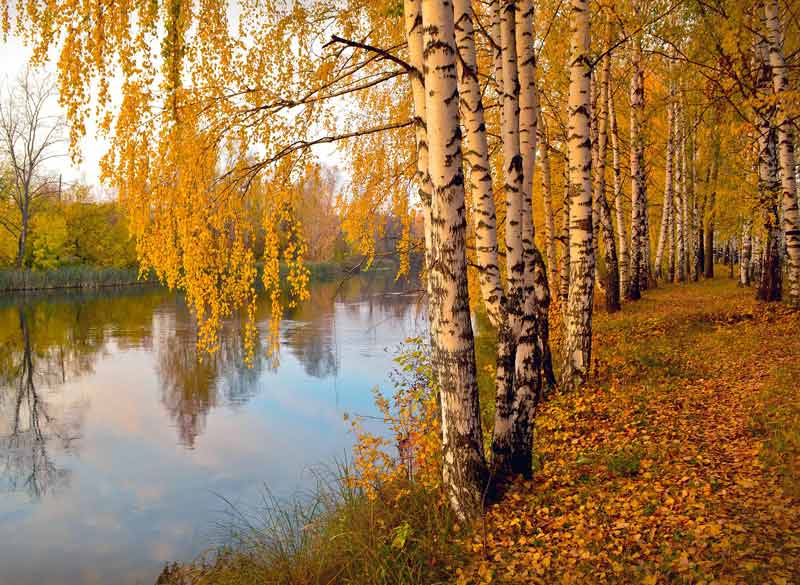
Also commonly found in Illinois, birch trees can be identified by their characteristic papery bark, tight cylindrical flower clusters, and brilliantly red and yellow coloration in the fall. The native yellow or golden birch is the most common variety encountered with river birches making up substantial portions as well.
Type of Tree: Deciduous.
Varieties: Yellow, gray, sweet, river, and paper birch trees are all common here in Illinois.
Height: 40-70 feet, depending on the variety in question.
Spread: 30-60 feet
Growth Rate: Generally an average of 1-2 feet per year.
Maximum Age: A healthy birch tree usually lives between 40-50 years with the white variety rarely reaching more than 20 years old. However, yellow birches can exceed 300 years old in the wild in rare cases!
Native to Illinois: Yes, the varieties listed above are all native to the state.
Advantages:
- Birch trees are a favorite of local birds.
- The wood makes for outstanding firewood, even when damp.
- Mature birches are highly-prized for their ornamental value.
- The river birch variety excels at preventing soil erosion.
Disadvantages:
- Vulnerable to invasive pests, as well as excess heat and humidity.
- Won’t flourish in soil with inadequate acidity.
- Birch sap can attract insects to your yard.
Black Cherry
The cherry tree is another excellent choice for Illinois. It is known for its beautiful blossoms, and it is also a very hardy tree. Cherry trees are also relatively resistant to disease and pests.
Type of Tree: Deciduous.
Varieties: While several subvarieties of the black cherry exist, the black cherry itself is a subspecies of the cherry tree having been cross-pollinated with the American serviceberry plant.
Height: 60-80 feet tall.
Spread: 30-50 feet.
Growth Rate: Up to 3 feet per year.
Maximum Age: While some specimens have reached more than 250 years old, the average lifespan is closer to 15-30 years.
Native to Illinois: Yes. The black cherry is native to both the midwest and the eastern United States.
Advantages:
- Black cherries so well in both urban and rural settings
- Are prized for their aesthetically-pleasing flowers and nutritious and flavorful fruits
- High quality of wood in furniture making
- Provide habitat for a wide variety of wildlife.
Disadvantages:
- Not tolerant of shade
- Vulnerable to tent caterpillars and various moth species, as well as diseases like black knot and cherry leaf spot
- The fruits can attract potentially unwanted wildlife to your yard.
Chestnut
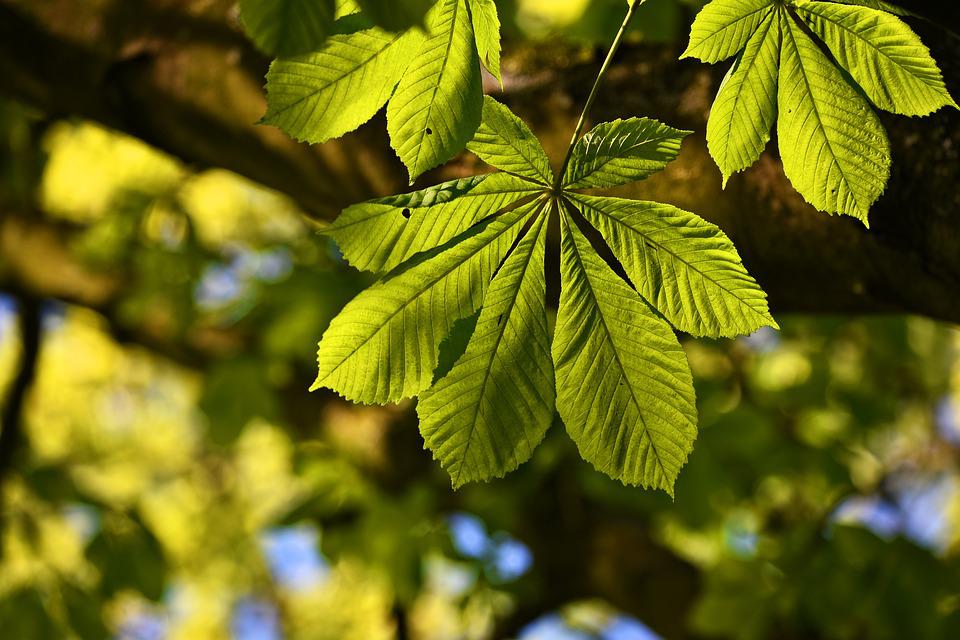
The American chestnut grows thick, robust bark with a distinctive orange-brown hue. Additionally, it can be identified by its long, bright green leaves which can reach up to 9 inches in length, terminating in a fine point. While it was once among the most dominant and majestic native tree species in North America, invasive diseases have both significantly reduced the standing population and resulted in smaller mature trees.
Type of Tree: Deciduous.
Varieties: While the American chestnut is the only native variety to our continent, the Chinese, Japanese, and European chestnuts are the other common varieties that can be found across the world.
Height: A healthy specimen can reach up to 100 feet tall but, owing to the proliferation of chestnut blight, trees maxing out at 30 feet are more common.
Spread: 50-75 feet under ideal circumstances.
Growth Rate: A fast-growing species, the American chestnut can grow between 4 and 7 feet each year.
Maximum Age: While old specimens are very rare nowadays and the species is listed as critically endangered, the American chestnut’s lifespan can exceed 500 years! Sadly, most modern individuals rarely live more than 10 years.
Native to Illinois: Yes. The American chestnut is native to much of the eastern and central United States.
Advantages:
- Historically, the American chestnut played an important role in ship making due to its dense, rot-resistant wood as well as the edible and nutritious nuts.
- The American chestnut is one of the continent’s most distinctive and well-regarded tree varieties.
Disadvantages:
- Highly vulnerable to chestnut blight which can dramatically reduce its lifespan and growth.
Crabapple
One of the more widespread fruiting trees found in North America, the chances are good that you’ve walked right by a crabapple tree many times without realizing it. Small and manageable though, this oft-maligned species can make for an excellent yard ornamental owing to their vibrant leaves and flowers.
Type of Tree: Deciduous.
Varieties: There are more than 50 varieties of crabapple trees found in North America, the four most common subspecies found in Illinois are the American, Prairie, Pacific, and Southern crabapple.
Height: Generally between 15 and 30 feet.
Spread: 20-30 feet.
Growth Rate: Crabapples are slow-growing trees, rarely exceeding 1 foot per year.
Maximum Age: Crabapple trees are relatively short-lived, averaging 30-70 years and only reaching 100 in highly unusual cases.
Native to Illinois: Out of the four common North American species, the Prairie and American varieties are native to Illinois.
Advantages:
- Once established, crabapple trees are low-maintenance and require minimal pruning.
- Their flowers and leaves will help your yard stand out during late summer and early fall.
Disadvantages:
- Vulnerable to a wide variety of pests and diseases, including apple scabs and fire blight.
- Require regular watering and good soil drainage when young.
- Don’t live as long as other ornamental varieties.
Dogwood
A common and widespread ornamental tree, dogwoods are prized for their aesthetically-pleasing flowers, foliage, and bark. Found throughout the North American continent, they’re some of the more popular trees in both city parks and private yards.
Type of Tree: Deciduous.
Varieties: There are 17 varieties of dogwood trees that are native to North America, the most common of which are flowering dogwoods, Pacific dogwood, Cornelian cherry dogwood, and kousa dogwoods.
Height: 15-25 feet.
Spread: 20-25 feet.
Growth Rate: 1-2 feet per year, on average.
Maximum Age: Most dogwoods in North America will live for up to 80 years when properly cared for.
Native to Illinois: Both the flowering and pagoda varieties of dogwoods are native to Illinois.
Advantages:
- Dogwoods are a true four-season tree with delicate, attractive flowers in the spring and summer, stunning leaf colors in fall, and highly-textured silvery bark which looks nice even after the leaves have fallen in winter.
Disadvantages:
- Both the flowering and pagoda dogwood struggle in drought conditions, but also don’t flourish with excess moisture, giving them a narrow water tolerance that can be difficult to keep up with for inexperienced gardeners.
Elm
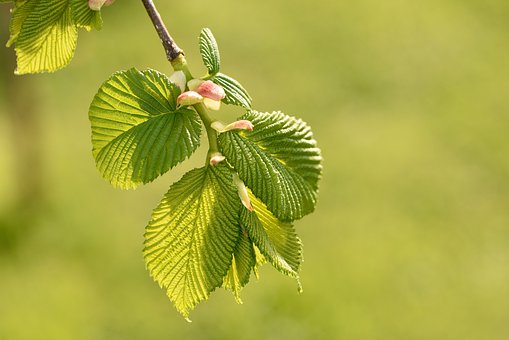
Elms are an ancient tree species, thought to have originated in Central Asia more than 20 million years ago! Once widespread across North America, many modern elm trees have succumbed to the highly infectious and destructive Dutch Elm Disease, making tall, mature specimens rare sights indeed.
Type of Tree: Deciduous and semi-deciduous, depending on the specific subspecies.
Varieties: Elms are one of the most varied and widespread tree species on Earth, with more than 40 subspecies known to exist. However, the most common in North America are the American elm, cedar elm, English elm, and slippery elm,
Height: A fully mature and healthy American elm can reach 80 feet in height with other native varieties maxing out at closer to 60 feet.
Spread: Generally no wider than 40-60 feet
Growth Rate: 3-6 feet per year.
Maximum Age: Up to 300 years when healthy.
Native to Illinois: The American elm, slippery elm, and the lesser-known winged elm are all considered to be native to Illinois.
Advantages:
- Most elms are hardy, condition-tolerant, and fast-growing.
- When mature, an elm tree’s dense foliage can provide your yard with outstanding shade.
Disadvantages:
- All of Illinois’ native elms are highly susceptible to Dutch Elm Disease, which can dramatically shorten both their lifespans and growth potential.
Fir
Differentiating a fir tree from the closely-related spruce and pine trees can be a challenge. According to Fine Gardening magazine, however, “If a twig bears needles in groups of two, three, or five, you can safely call it a pine. If the twig carries its needles singly, it’s a good bet you’ve got a fir or a spruce.” Once you’ve actually identified which tree you have, of course, you’ll find fir trees both evocative to look at and pleasant to own owing to their year-round vibrant color, classic shape, and instantly-recognizable fragrance.
Type of Tree: Evergreen.
Varieties: While the Douglas fir, otherwise simply known as the Christmas tree, is the most famous example of the species, other North American varieties include the balsam fir, Frasier fir, grand fir, noble fir, red fir, subalpine fir, and white fir.
Height: Anywhere from 15-40 feet, depending on the variety. Some Douglas firs can reach 80 feet tall under ideal circumstances, however.
Spread: Up to 20 feet when fully grown.
Growth Rate: Most varieties will grow 1-2 feet per year.
Maximum Age: In the wild, some fir trees have been known to exceed 1000 years old! However, most domesticated specimens will not live longer than 60 years with maximum ages closer to 20 being more common.
Native to Illinois: No
Advantages:
- Like many evergreens, firs are low-maintenance plants that require minimal intervention to thrive. This makes them ideal for inexperienced gardeners.
Disadvantages:
- Most fir trees are highly region-dependent and don’t do well outside of their preferred climate. Therefore, knowing exactly which variety you intend to plant in your yard is critical.
Hickory
One of America’s more iconic native tree species, hickory trees have both dotted our landscapes and contributed to both our history and households for hundreds of years. Eastern Native American tribes would use the bark for dyes, the nuts of some varieties for food, and even the wood ash for soapmaking.
The dense, shock-resistant wood remains a favorite among tool and furniture makers as well as making for an outstanding choice for wood-burning stoves. Until more recent times, baseball bats were even made from hickory, so chances are that this magnificent tree has touched your life in ways that you may never have realized!
Type of Tree: Deciduous.
Varieties: The most common varieties of hickory trees found in North America are the shagbark hickory, shellback hickory, mockernut hickory, pignut hickory, bitternut hickory, and the pecan tree which is a subspecies of hickory!
Height: Most varieties will reach 40-60 feet tall.
Spread: Generally around 40 feet.
Growth Rate: Hickory trees are a slow-growing species, rarely eclipsing 1 foot per year.
Maximum Age: Most hickories will live to be about 200 years old with some shagbarks reaching 300 and rare specimens exceeding 500 years of age.
Native to Illinois: Of the native North American hickory varieties, only the shagbark is native to Illinois.
Advantages:
- Hickories are tolerant of a wide variety of soil types and are exceptionally disease-resistant, making them ideal ornamental and shade trees for a mature yard.
Disadvantages:
- All hickory tree varieties require excellent soil drainage and will need plenty of growing space to reach their full height and width.
- Additionally, fallen hickory nuts can be a pain to clean up for the reluctant gardener.
Japanese Maple
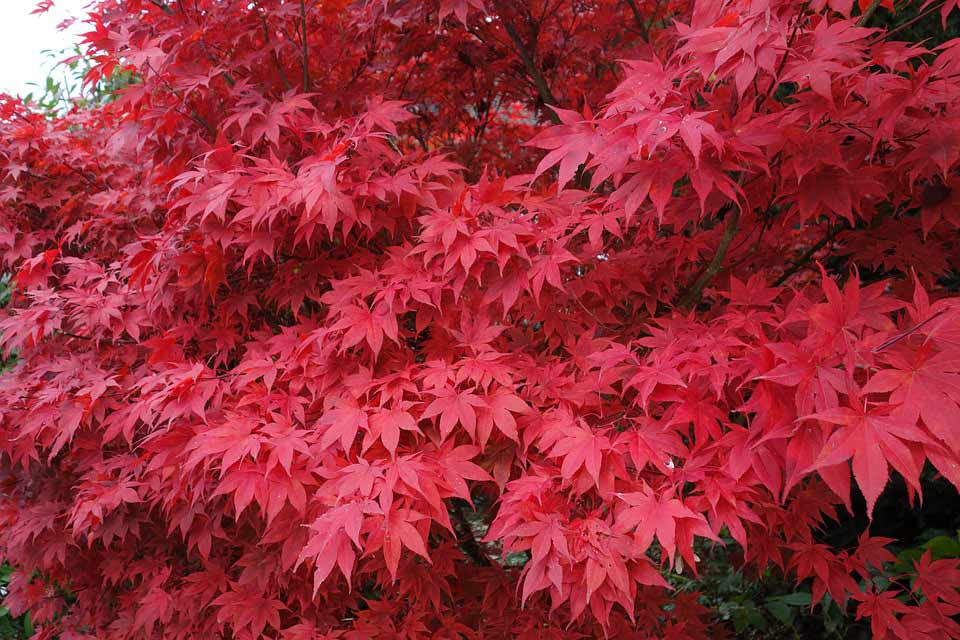
One of the most striking and dramatic yard plants that you’ll find anywhere, a Japanese maple makes a statement wherever it’s found. With stunning foliage ranging from bright red to dark purple, and even light pink, adding a Japanese maple to your yard is a great way to introduce both color and variety that so many landscapes sorely need.
Type of Tree: Deciduous.
Varieties: While the Japanese maple is itself a subspecies of the maple tree, a few popular subvarieties include the butterfly, coral bark, red dragon, and Bloodgood.
Height: Japanese maples will typically max out at 25 feet tall with specimens as short as 15 feet commonly found.
Spread: Usually around 20 feet.
Growth Rate: 1-2 feet per year.
Maximum Age: When properly cared for, a Japanese Maple can live to be about 100 years old.
Native to Illinois: No. The Japanese maple is native to Japan, China, Korea, and Eastern Mongolia.
Advantages:
- Their relatively small size makes them ideal for planting in smaller yards or for filling in awkward gaps in your landscaping.
- Their non-invasive root systems generally don’t push up sidewalks or grow through pipes, making them a solid choice for an urban environment.
Disadvantages:
- Their small stature makes them versatile, but their thin branches have trouble standing up to heavy snow or strong winds.
- Japanese maples are also quite expensive with small, young specimens routinely costing more than $200 per tree.
Magnolia
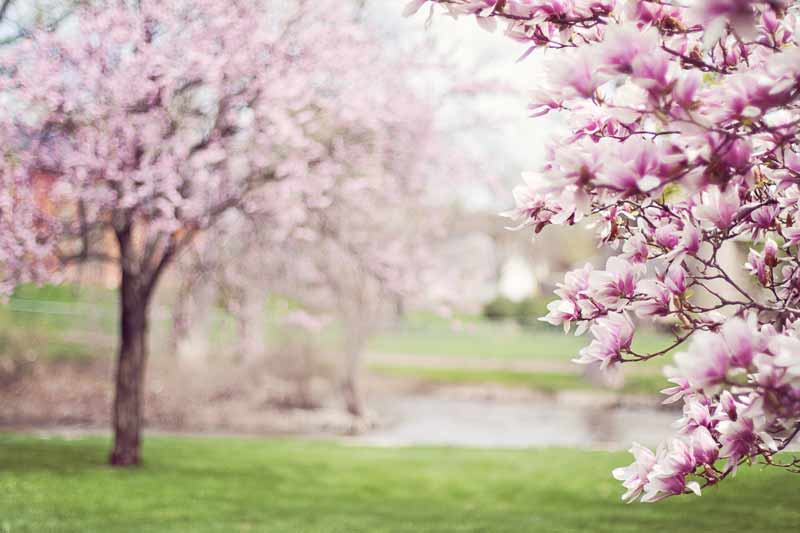
Another of America’s most iconic trees, particularly down south, the magnolia tree’s large leather leaves and impressive pink and white flowers will instantly make it stand out in your yard. Additionally, their characteristic fragrance makes them one of the more recognizable flowering trees around.
Type of Tree: Depending on the subspecies and growing region, magnolias are considered to be either deciduous or evergreen.
Varieties: Worldwide, there are as many as 340 varieties of the magnolia tree, with more than 80 native to the United States. The Jane, bigleaf, southern, star, sweet bay, umbrella varieties, as well as the curiously-named cucumber tree, make up the bulk of the magnolia population.
Height: A magnolia’s height is heavily dependent on the variety in question and can range anywhere from 15-80 feet.
Spread: Mature Magnolias can achieve a canopy spread of up to 50 feet.
Growth Rate: Most common magnolia varieties will grow between 1 and 2 feet per year.
Maximum Age: 80-120 years, depending on growing region and care.
Native to Illinois: The cucumber tree is Illinois’ only native magnolia variety.
Advantages:
- You’d be hard-pressed to find a more attractive or iconic ornamental to add to your landscaping.
- Additionally, most varieties are tolerant of both a wide variety of shade and light conditions and can withstand long periods of drought.
Disadvantages:
- Most magnolias require a lot of space and don’t like any other plants to be particularly close to them. This means that, if you want a gorgeous magnolia on your property, you’d better have a big yard!
- Their fallen blossoms can also be a mess and give off an unpleasant odor as they decompose.
Redbud
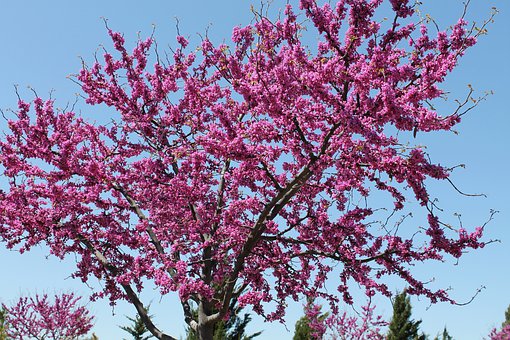
One of the more cheerful and picturesque flowering trees that you’ll ever encounter, the redbud can represent an excellent addition to yards of many different sizes. Their shiny bark and soft, pink flowers always serve to make them a standout, which is why they’re such a popular choice for domestic and municipal landscaping alike.
Type of Tree: Deciduous.
Varieties: While the eastern redbud is far and away the most common variety of redbud trees found in the United States, the western, chain flowered, Texas, and Mexican varieties can all be seen in their native growing regions.
Height: The eastern redbud will reach 20-30 feet tall.
Spread: 25-35 feet in height.
Growth Rate: Usually around 1-2 feet per year.
Maximum Age: A relatively short-lived species, redbuds typically live for 20-40 years.
Native to Illinois: Yes, the eastern redbud is native to Illinois.
Advantages:
- Most redbuds are heavily drought-tolerant and their striking flowers tend to last for a long time, particularly compared to other flowering varieties.
- On top of that, their diminutive stature allows them to fit well into smaller yards.
Disadvantages:
- Some redbuds are highly vulnerable to disease, including both verticillium wilt, a wilt disease caused by fungi, and various trunk cancers which can drastically decrease their life expectancy.
- Young specimens also require frequent watering to become established.
Red Maple
The red maple, in addition to being a beautiful tree that is well-suited to the climate in Illinois, is the most abundant native tree in the United States. It is a hardy tree that can tolerate cold winters and hot summers, and it will provide shade and beauty for your home or business.
Type of Tree: Deciduous.
Varieties: Most subvarieties of the red maple, which of course is a variety of maple tree, are lab-created cultivars which nevertheless, have taken well the growing across North America, A few examples include the October glory, supersonic, ruby frost, Armstrong, and autumn flame.
Height: 40-60 feet at full maturity although some trees have been known to exceed 100 feet tall.
Spread: Roughly 40 feet.
Growth Rate: Healthy red maples will grow between 1 and 2 feet yearly.
Maximum Age: A red maple tree will typically live for 60-90 years with specimens as old as 200 having been observed.
Native to Illinois: Yes, the red maple is native to Illinois, occurring most commonly in the southern and northeastern parts of the state.
Advantages:
- In addition to the red maple’s striking scarlet foliage, they show only a minor susceptibility to pests and disease, making them a low-maintenance option for your landscaping needs.
Disadvantages:
Relative to their size, red maples have weak trunks and branches, meaning that they’ve been known to fall in heavy wind, rain, and snow.
Sugar Maple
The sugar maple is another excellent choice for Illinois. It is a very popular tree, and it is known for its stunning fall foliage. Sugar maples are also very resistant to disease and pests, making them a low-maintenance option.
Type of Tree: Deciduous.
Varieties: Common subvarieties of the sugar maple include the southern sugar maple, green mountain sugar maple, legacy sugar maple, and chalkbark maple.
Height: Most specimens will reach 50-80 feet tall.
Spread: 40-50 feet wide.
Growth Rate: Sugar maples grow slowly, rarely surpassing 1 foot per year.
Maximum Age: Sugar maples can live for 200 to 400 years, making them the longest-living variety of maple.
Native to Illinois: Yes, the sugar maple is both native to and widespread in Illinois.
Advantages:
- Without the sugar maple, there would be no maple syrup, and that’s simply not a world we want to live in!
- On top of that, sugar maples display some of the most dramatic and dynamic fall foliage you’ll find anywhere with their leaves taking on vibrant yellow, orange, and red colors.
Disadvantages:
- While generally hardy, the sugar maple requires full sun, excellent soil drainage, and lots of space.
- It can be vulnerable to both insects and disease and does not do well in prolonged periods of drought.
Sweetgum
At a brief glance, it’s easy to confuse the sweetgum for a variety of maple. Its signature 5-lobed leaves however are more elongated than a maple’s and their characteristic spiky, round seed pods, which give sweetgums the nickname of, “Gumball trees,” set them far apart.
Type of Tree: Deciduous.
Varieties: In addition to the common American sweetgum, the fruitless sweetgum, variegated sweetgum, and Chinese sweetgum are also widely seen across many North American growing regions.
Height: Sweetgums can reach heights in excess of 150 feet tall but specimens in the 60-75 foot range are more common.
Spread: 40-50 feet at maturity.
Growth Rate: 2-3 feet per year.
Maximum Age: One of the longer-lived native North American trees, the sweetgum can live to be more than 400 years old!
Native to Illinois: Yes, the sweetgum occurs naturally in southern Illinois.
Advantages:
- Each fall, sweetgums put on a show with their star-shaped leaves taking on a deep red color.
- Their tight canopies also create reliable and refreshing shade in both yards and parks.
Disadvantages:
- Cleaning up sweetgum seed pods, which a mature tree can drop in alarming numbers, are a notoriously frustrating challenge for even an experienced gardener.
- Sweetgums are considered a pioneer species, meaning that they can easily propagate in areas where they are non-native and become invasive without proper population management.
White Oak
White oaks are known for their strength and durability, and they can provide a stunning visual impact. They are also very resistant to disease and pests. One of the most important trees during the colonial and post-colonial period of American history, white oaks have long been prized in ship making due to their strong, dense wood and resistance to moisture. In modern times, white oak is an essential component of barrel making in both the wine and whiskey industries.
Type of Tree: Deciduous.
Varieties: White oaks are a part of the beech tree family and there are more than 500 species of oak that occur naturally the world over. Of those, 90 are native to the United States including live oaks, southern live oaks, red oaks, and short oaks.
Height: Most mature white oaks will reach a maximum height of 50-80 feet tall with some individuals growing taller than 100 feet.
Spread: Generally between 50 and 80 feet.
Growth Rate: The white oak grows slowly, averaging 1-2 feet per year.
Maximum Age: Typically, white oaks will live for 200-300 years with the oldest recorded example in the United States being 582 years old.
Native to Illinois: Yes, more than 20 subspecies of white oak are native to Illinois.
Advantages:
- In addition to being an outstanding shade tree and adding tremendous character to your yard, white oak trees’ acorns are an important source of food for a wide variety of wildlife and their dense wood makes them both hardy and resistant to damage.
Disadvantages:
- Like most oak trees, white oaks require both large amounts of space and direct sunlight which means they won’t thrive in small or shaded yards.
- Acorns can also fall in immense numbers from a mature tree and be a pain to clean up on your own.
Willow
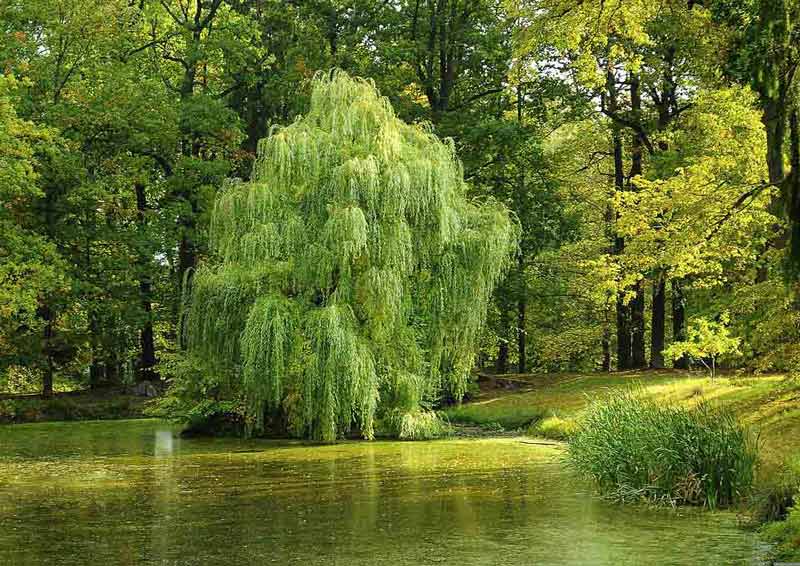
A charismatic and widespread tree species, there are more than 400 varieties of willows from across the world, primarily in cool and temperate climates. Their characteristic slender, sometimes drooping branches and elongated leaves make them instantly recognizable and among the most aesthetically pleasing ornamentals around.
Type of Tree: Most willow species are considered deciduous.
Varieties: Commonly occurring varieties of willow trees in North America include the Bebb willow, narrow-leaf willow, peach leaf willow, pussy willow, black willow Scouler’s willow, and yellow willow.
Height: There is tremendous variance in willow tree height, depending on the variety in question. Some subspecies will reach heights of 50 and even 100 feet, others max out at 25 feet or less.
Spread: Again, this is highly dependent on the variety of willow trees. Some can have a spread of 40-50 feet while others are much, much smaller.
Growth Rate: Most willows are fast-growing, with some varieties growing 6-8 feet per year when healthy.
Maximum Age: Most willows are relatively short-lived with noticeable decline happening at around 20 years old and lifespans rarely eclipsing 50 years.
Native to Illinois: The black willow is the only native variety to Illinois. This is one of the taller subspecies and can often reach nearly 75 feet tall.
Advantages:
- Willows are prized for their beauty and can add a feeling of serenity to any landscape.
- Willows are also of surprising value to the cosmetics industry with their watery sap containing high concentrations of salicylic acid.
Disadvantages:
- While willows are undeniably beautiful, some varieties are known to be high maintenance, picky regarding their growing conditions, and require lots of space to thrive.
- This, combined with their short lifespans, make them less than ideal for inexperienced landscapers.
When choosing trees to plant in Illinois, it is important to consider the climate and the soil type in your area. You should also consider the size of the tree and the amount of maintenance it will require. With careful planning, you can choose trees that will thrive in Illinois and provide you with years of enjoyment. For more insights, schedule a free consultation with one of our experienced team members.
